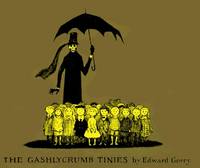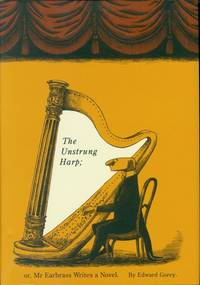John Gorey (February 22, 1925-April 15, 2000) was a writer and artist noted for his wry, macabre illustrated books.
Born in Chicago, Gorey attended a variety of local grade schools and then the Francis W. Parker School. He spent 1944–1946 in the Army at Dugway Proving Ground, and then attended Harvard University from 1946 to 1950, where he studied French and roomed with future poet Frank O'Hara.
Although he would frequently state that his formal art training was "negligible," Gorey studied art for one semester at the Chicago Art Institute in 1943, eventually becoming a professional illustrator. From 1953 to 1960 he lived in New York City and worked for the Art Department of Doubleday Anchor, illustrating book covers. His first work,
The Unstrung Harp,, was published in 1953. He also published under pen names such as "Ogdred Weary," an anagram of his first and last names.
Gorey's illustrated (and sometimes wordless) books, with their vaguely ominous air and ostensibly Victorian and Edwardian settings, have long had a cult following. However, Gorey became particularly well-known through his animated introduction to the PBS series Mystery! in 1980, and his designs for the 1977 Broadway production of
Dracula, for which he won a Tony Award for Best Costume Design and was also nominated for Best Scenic Design.
The settings and style of Gorey's work have caused many people to assume he was British; in fact, he only visited the United Kingdom once, on a trip to the Scottish Isles. In later years, he lived year-round in Yarmouth Port, Massachusetts on Cape Cod, where he wrote and directed numerous evening-length entertainments, often featuring his own papier-mache puppets, in an ensemble known as La Theatricule Stoique. His major theatrical work was the libretto for an "Opera Seria for Handpuppets," The White Canoe, to a score by the composer Daniel James Wolf. Based on the Lady of the Lake legend, the opera premiered posthumously. On August 13, 1987, his play "Lost Shoelaces" premiered in Woods Hole, Massachusetts.
Gorey was noted for his fondness for ballet (for many years, he religiously attended all performances of the New York City Ballet) and cats, of which he had many. Both figure prominently in his work. His knowledge of literature and films was unusually extensive, and in his interviews, he named as some of his favorite artists Jane Austen, Francis Bacon, George Balanchine, Balthus, Louis Feuillade, Ronald Firbank, Lady Murasaki Shikibu, Robert Musil, Yasujiro Ozu, Anthony Trollope, and Johannes Vermeer.
From 1996 to his death in April 2000, the normally reclusive artist was the subject of a direct cinema-style documentary directed by Christopher Seufert of Mooncusser Films. This has yet to be released. His Cape Cod house is called Elephant House and is the subject of a photography book entitled Elephant House: Or, the Home of
Edward Gorey, with photographs and text by Kevin McDermott. The house now serves as a gallery and museum of sorts.
Gorey was very fond of word games, particularly anagrams. He wrote many of his books under pseudonyms that were usually anagrams of his own name (most famously "Ogdred Weary"). Some of these are listed below, with the corresponding book title(s). "Eduard Blutig" is also a word game: "Blutig" is German (the language from which these two books were purportedly translated) for "bloody," which is a synonym for "gory."
* Ogdred Weary - The Beastly Baby
* Mrs. Regera Dowdy - The Pious Infant
* Eduard Blutig - The Tuning Fork (translated from Der Zeitirrthum by Mrs. Regera Dowdy)
* Raddory Gewe - The Eleventh Episode
* Dogear Wryde - The Broken Spoke/Cycling Cards
* E. G. Deadworry -
The Awdrey-Gore Legacy
* D. Awdrey-Gore - The Toastrack Enigma, The Blancmange Tragedy, The Postcard Mystery, The Pincushion Affair, The Toothpaste Murder, The Dustwrapper Secret (Note: These books, though attributed to Awdrey-Gore in Gorey's book, The Awdrey-Gore Legacy, were not really written.)
* Edward Pig - "[The Untitled Book]"



































